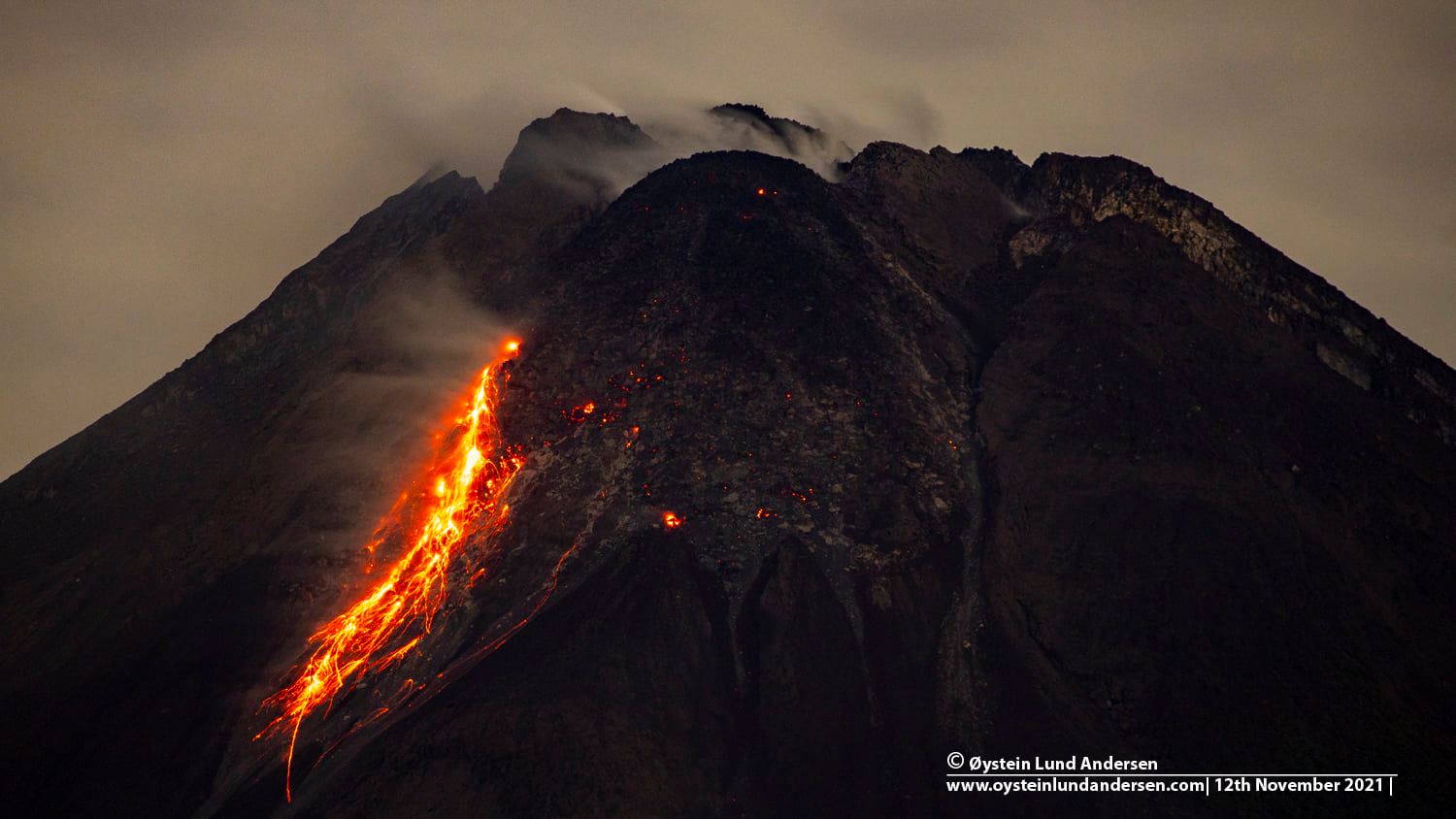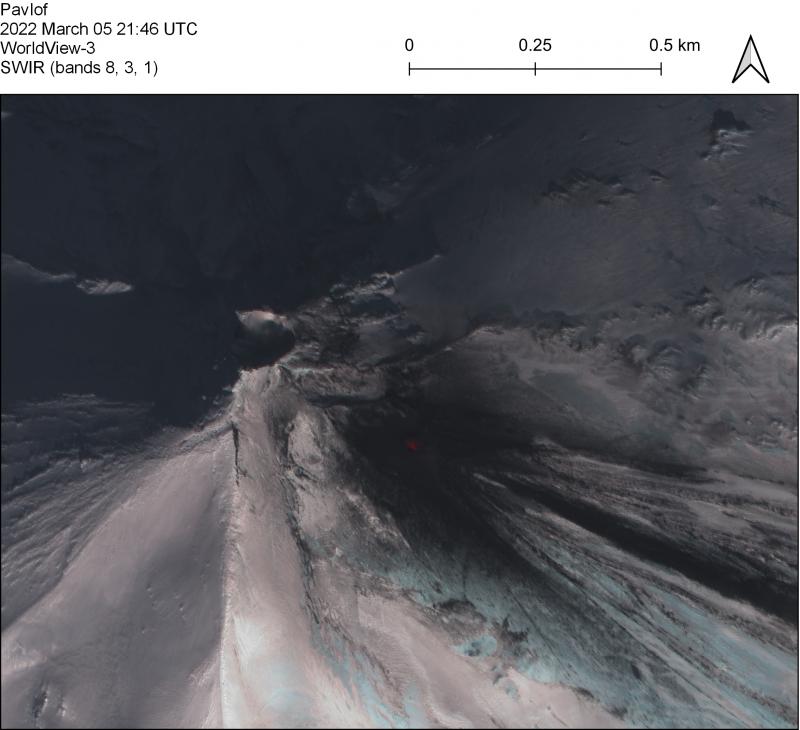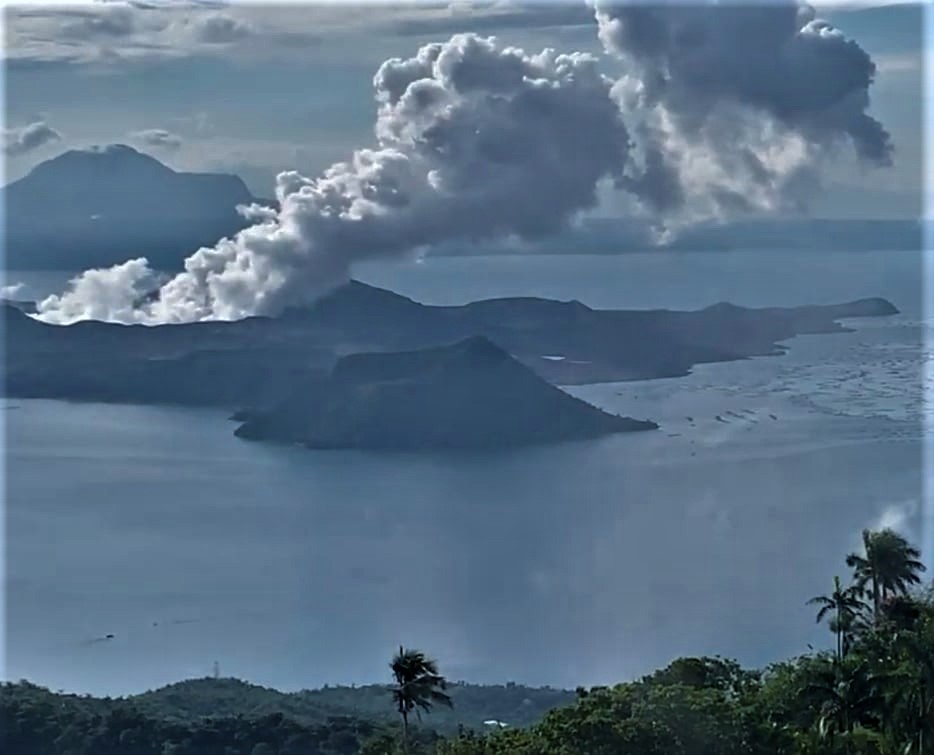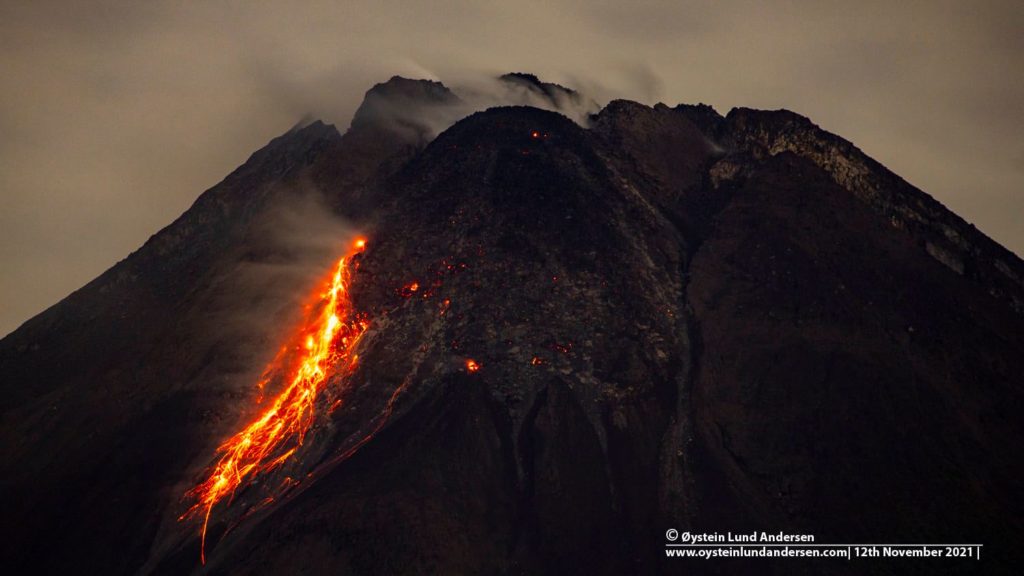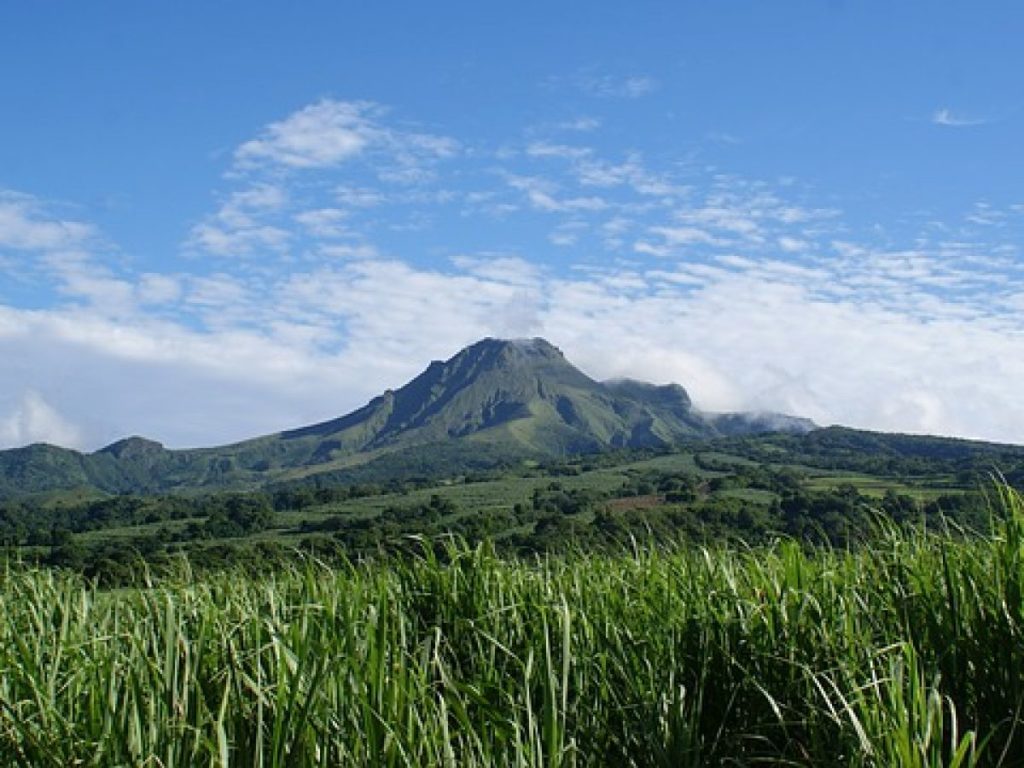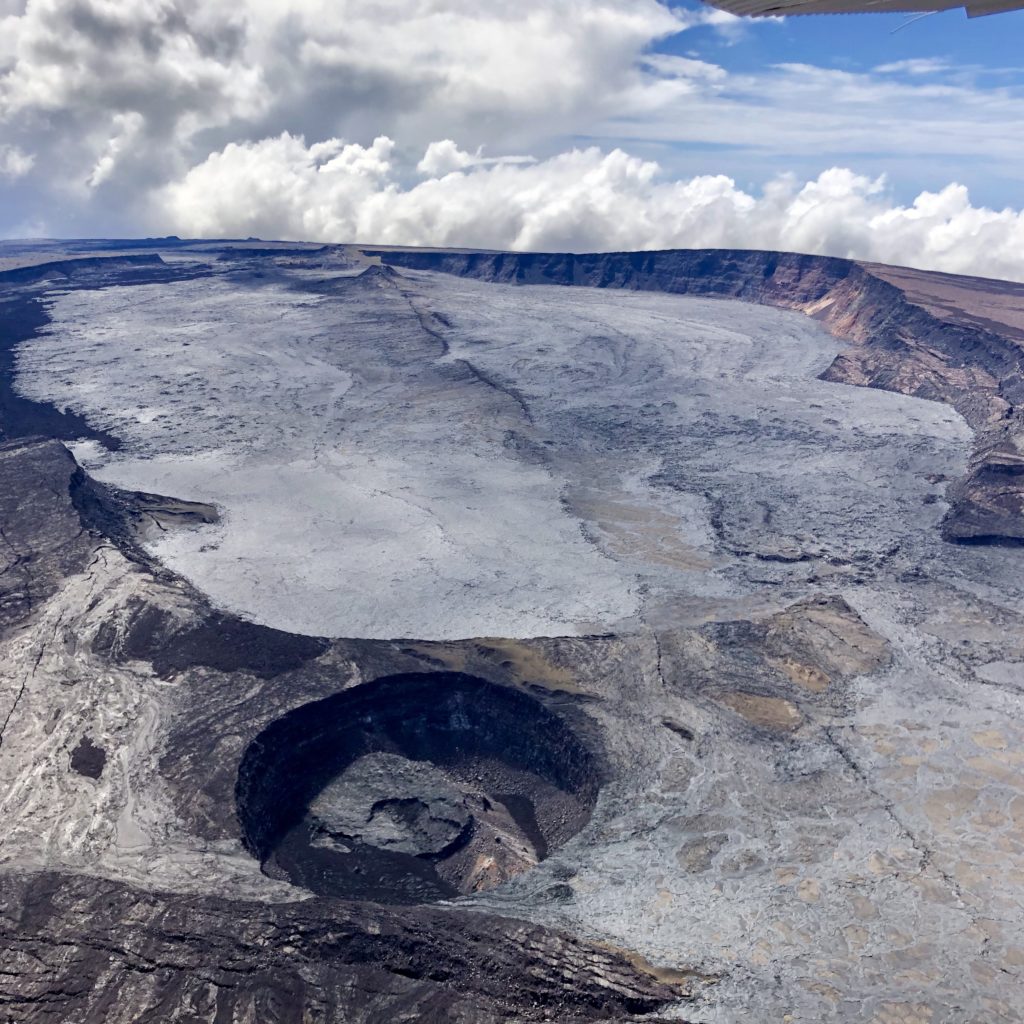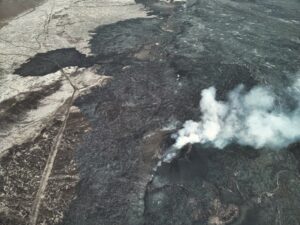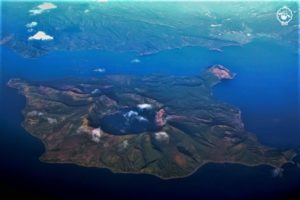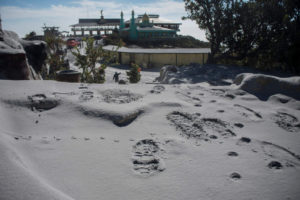April 09 , 2022.
Alaska , Pavlof :
55°25’2″ N 161°53’37 » W,
Summit Elevation 8261 ft (2518 m)
Current Volcano Alert Level: WATCH
Current Aviation Color Code: ORANGE
Pavlof Volcano continues to erupt from the east vent near the volcano’s summit, and occasional small explosions producing minor ash emissions were observed in local geophysical and web camera data. When satellite views were clear, imagery captured elevated surface temperatures and minor ash and steam emissions throughout the week. Possible weak lava effusion from the east vent was observed on April 6. Seismicity also remains elevated with near-continuous tremor recorded on the local network.
Near-IR false color WorldView-3 satellite image on March 5 at Pavlof. No active lava flows are visible but the active east vent is hot (near-IR red) and ballistic impacts are visible in the snow around this vent. Only steaming is visible from the north vent.
Periods of lava spatter and fountaining from the vent on the volcano’s upper east flank have been occurring since mid-November 2021. This activity has built a small cone and sent flows down the flank that melt the snow and ice and produce variable amounts of meltwater. The meltwater typically incorporates loose debris on the flank of the volcano and forms thin (less than 2 m thick) lahars. The lahar deposits extend down the east-southeast flank for several kilometers, not quite to the base of the volcano.
Previous eruptions of Pavlof indicate that the level of unrest can change quickly and the progression to more significant eruptive activity can occur with little or no warning.
Pavlof is monitored by local seismic and infrasound sensors, satellite data, web cameras, and remote infrasound and lightning networks.
Source : AVO
Photo : Loewen, M. W.
Philippines , Taal :
TAAL VOLCANO BULLETIN 9 April 2022 08:00 AM
This serves as a notice for the lowering of Taal Volcano’s status from Alert Level 3 (Magmatic Unrest) to Alert Level 2 (Decreased Unrest).
Following the phreatomagmatic eruption of the Main Crater on 26 March 2022 and six (6) weak phreatomagmatic bursts until 31 March 2022, unrest at Taal Volcano has markedly declined. Activity in the past two weeks has been characterized by a significant drop in volcanic degassing from the Main Crater and in the incidence of volcanic earthquakes. The decline in unrest is supported by the following observations:
1. Since the 26 March 2022 eruption, only 86 small-magnitude and imperceptible volcanic earthquakes have been recorded by the Taal Volcano Network (TVN). These consist of 26 volcanic tremors, 59 low-frequency volcanic earthquakes, and 1 volcano-tectonic event, most of which occurred 0-7 kilometers beneath the Main Crater and the eastern sector of Taal Volcano Island or TVI. Most earthquakes were generated by volcanic degassing from the shallow magma and hydrothermal region beneath the TVI edifice. In addition, background tremor associated with shallow hydrothermal activity ceased on 31 March. There has been no recorded seismic activity related to new magmatic intrusions from Taal’s deeper magma source since unrest began last year.
2. After sulfur dioxide or SO2 gas flux elevated in the first three weeks of March 2022 and peaked at 21,211 tonnes/day on 16 March, emissions suddenly dropped on 3 April 2022. SO2 flux since then has averaged 240 tonnes/day, decreasing to 103 tonnes/day yesterday, 8 April, the lowest flux recorded since unrest began in 2021. The rise in SO2 emissions prior to the 26 March phreatomagmatic eruption and its subsequent drop indicate that accumulated volcanic gas drives this type of eruptive activity at the Main Crater. Recent volcanic gas emissions, therefore, suggest that the potential for eruptive activity at present is low.
3. Ground deformation parameters for the period January 2021 to April 2022 from electronic tilt monitoring on TVI and continuous Global Positioning System (GPS) and InSAR analysis of Sentinel-1 satellite data over Taal Caldera indicated a general deflation of Taal centered on eastern TVI. GPS data further recorded deflation of TVI by as much as 11 centimeters on the southeastern flank. These parameters are all broadly consistent with depressurization of the hydrothermal region beneath TVI due to continuous degassing and gas release by phreatomagmatic activity at the Main Crater.
4. Activity in the Main Crater in the past week has been characterized by occasional weak plumes and longer periods of absence thereof, consistent with the significant decrease in magmatic degassing.
In view of the above observations, DOST-PHIVOLCS is lowering the alert status of Taal Volcano from Alert Level 3 to Alert Level 2 to reflect the overall decreasing trend in the level of monitoring parameters. Alert Level 2 means that there is decreased unrest but should not be interpreted that unrest has ceased or that the threat of an eruption has disappeared. Should an uptrend or pronounced change in monitored parameters occur, the Alert Level may be raised back to Alert Level 3. At such time, people residing within areas at high risk to base surges who have returned after the step-down to Alert Level 2 must therefore be prepared for a quick and organized evacuation. Conversely, should there be a persistent downtrend in monitored parameters after a sufficient observation period, the Alert Level will be further lowered to Alert Level 1.
Source : Phivolcs.
Photos : Kyle Aranza , Raffy Tima .
Indonesia , Merapi :
Merapi activity report, from April 1 to 07, 2022
This week, there were 1 hot avalanches towards the South-West with a sliding distance of 1,500 m. Lava avalanches were observed 144 times towards the southwest, descending the Bebeng River with a maximum slip distance of 2,000 m.
– According to photo analysis, the volume of the southwest lava dome is 1,672,000 m3 and the central dome is 2,582,000 m3.
Seismicity:
This week, the seismicity of Mount Merapi recorded:
1 hot avalanche earthquakes (APG),
2 shallow volcanic earthquakes (VTB),
18 multi-phase earthquakes (MP),
778 avalanche earthquakes (RF),
5 emission earthquakes (DG),
13 tectonic earthquakes (TT).
The intensity of seismicity this week is still quite high. Mount Merapi’s deformation, which was monitored using EDM this week, showed a distance shortening rate of 0.3 cm/day.
– The precipitation intensity was 82 mm/hour for 30 minutes at Kaliurang post on April 07, 2022. It was reported that lahars occurred in Senowo river on April 4, in Boyong and Gendol rivers on April 5, in Gendol and Pabelan rivers on April 7.
Conclusion:
1. The volcanic activity of Mount Merapi is still quite high in the form of effusive eruption activity. The state of the activity is defined at the « SIAGA » level.
2. The current potential danger is lava avalanches and hot clouds in the South-South-West sector covering the Boyong River for a maximum of 5 km, the Bedog River, Krasak, Bebeng for a maximum of 7 km. The Southeast sector covers the Woro River for a maximum of 3 km and the Gendol River for a maximum of 5 km. Meanwhile, the ejection of volcanic material in the event of an explosive eruption can reach a radius of 3 km around the summit.
The public should not carry out any activity in potentially dangerous areas, anticipate disturbances due to volcanic ash from the eruption of Mount Merapi and be aware of the dangers of lahars, especially when it rains around Mount Merapi.
Source : BPPTKG
Photo : Oystein Lund Andersen
La Martinique , Mount Pelée :
Weekly report on the activity of Mount Pelee for the period from April 01 to 08, 2022.
Between April 1, 2022 at 4 p.m. (UTC) and April 8, 2022 at 4 p.m. (UTC), the OVSM recorded at least 8 volcano-tectonic earthquakes of magnitude less than or equal to 0.1. These earthquakes were located inside the volcanic edifice between 0.7 and 1.5 km deep below the surface. This superficial volcano-tectonic seismicity is associated with the formation of micro-fractures in the volcanic edifice.
During this period, the OVSM also recorded 1 hybrid type earthquake. This signal, containing low frequencies, is associated with the presence of fluids (gas, hydrothermal waters) in the volcanic edifice.
None of these earthquakes were felt by the population.
The zone of degassing at sea at shallow depth between St Pierre and le Prêcheur is still observed. The IGP took fluid samples in order to understand the origin of this degassing and to assess its possible relationship with the Mount Pelée hydrothermal system.
An extension of two areas of degraded vegetation located between Morne Plumé and the Chaude River was observed during a helicopter flight carried out on February 9, with the support of the Dragon 972, and confirmed by analysis of satellite images.
The alert level remains YELLOW: vigilance.
Source : Direction de l’OVSM IPGP.
Photo : Antilles prestige
Hawaii , Mauna Loa :
19°28’30 » N 155°36’29 » W,
Summit Elevation 13681 ft (4170 m)
Current Volcano Alert Level: ADVISORY
Current Aviation Color Code: YELLOW
Activity Summary:
Mauna Loa Volcano is not erupting. Rates of seismicity remain slightly elevated above long-term background levels, but have not changed significantly over the past week. Other Mauna Loa monitoring data streams—ground deformation, gas concentrations, visual appearance in webcams—show no significant changes.
Observations:
During the past week, HVO seismometers recorded approximately 67 small-magnitude (below M3.0) earthquakes below the summit and upper-elevation flanks of Mauna Loa. The majority of these earthquakes occurred at shallow depths less than 15 kilometers (9 miles) below sea level.
Global Positioning System (GPS) measurements show very low rates of deformation in the volcano’s summit region continuing through the past week.
Concentrations of sulfur dioxide (SO2), hydrogen sulfide (H2S), and carbon dioxide (CO2), as well as fumarole temperatures, remain stable at both the summit and at Sulphur Cone on the upper Southwest Rift Zone.
Webcam views have shown no changes to the volcanic landscape on Mauna Loa over the past week.
Source et photo : HVO.

